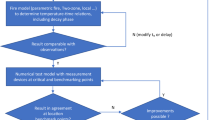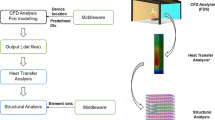Abstract
Advanced simulation methods are needed to predict the complex behavior of structures exposed to realistic fires. Fire dynamics simulator (FDS) is a computational fluid dynamics code, developed by NIST for fire related simulations. In recent years, there has been an increase in use of FDS for performance-based analysis in the area of structural fire research. This paper discusses the FDS–finite element method (FEM) simulation methodology for structural fire analysis. The general methodology is described and a validation study is presented. A data element used to transfer data from FDS to FEM codes, the adiabatic surface temperature, is discussed. A tool named fire-thermomechanical interface is applied to transfer data from FDS to ANSYS. A high temperature stress–strain model for structural steel developed by NIST is included in the FEM analysis. Compared to experimental results, the FDS–FEM method predicted both the thermal and structural responses of a steel column in a localized fire test. The column buckling time was predicted with a maximum error of 7.8%. Based on these results, this methodology has potential to be used in performance-based analysis.



















Similar content being viewed by others
Notes
Certain commercial entities, equipment, or materials may be identified in this document in order to describe an experimental procedure or concept adequately. Such identification is not intended to imply recommendation or endorsement by the National Institute of Standards and Technology, nor is it intended to imply that the entities, materials, or equipment are necessarily the best available for the purpose.
References
Bisby L, Gales J, Maluk C (2013) A contemporary review of large-scale non-standard structural fire testing. Fire Sci Rev 2:1–27
Li GQ, Zhang C (2009) Fire resistance of restrained steel components. In: Proceedings of the fourth international conference on protection of structures against hazards, Beijing, China, pp 21–38
Lamont S (2001) The behaviour of multi-storey composite steel framed structures in response to compartment fires. PhD thesis, University of Edinburgh
Zhang C, Li GQ, Usmani A (2013) Simulating the behavior of restrained steel beams to flame impinged localized fires. J Constr Steel Res 83:156–165
Zhang C, Gross JL, McAllister T (2013) Lateral torsional buckling of steel w-beams to localized fires. J Constr Steel Res 88:330–338
Zhang C, Gross JL, McAllister TP, Li GQ (2014) Behavior of unrestrained and restrained bare steel columns subjected to localized fire. J Struct Eng-ASCE
Li GQ, Zhang C (2013) The chinese performance-based code for fire-resistance of steel structures. Int J High-Rise Build 2:123–130
McGrattan KB (2005) Fire modeling: where are we? where are we going? Fire Saf Sci 8:53–68
Gann RG, Hamins A, McGrattan K, Nelson HE, Ohlemiller TJ, Prasad KR, Pitts WM (2013) Reconstruction of the fires and thermal environment in World Trade Center Buildings 1, 2, and 7. Fire Technol 49:697–707. doi:10.1007/s10694-012-0288-3
Henneton N, Roosefid M, Zhao B (2014) Application of structural fire safety engineering to the canopy of the forum DES Halles, in Paris. In Proceedings of the 8th international conference on structures in fire, pp 1047–1054
McAllister TP, Sadek F, Gross JL, Kirkpatrick S, MacNeill RA, Bocchieri RT, Zarghamee M, Erbay OO, Sarawit AT (2013) Structural analysis of impact damage to World Trade Center Buildings 1, 2, and 7. Fire Technol 49:615–642. doi:10.1007/s10694-012-0286-5
Welch S, Miles SD, Kumar S, Lemaire T, Chan A (2008) Firestruc—integrating advanced three-dimensional modelling methodologies for predicting thermo-mechanical behaviour of steel and composite structures subjected to natural fires. Fire Saf Sci 9:1315–1326
McGrattan K, Hostikka S, McDermott R, Floyd J, Weinschenk C, Overholt K (2013) Fire dynamics simulator, user’s guide. National Institute of Standards and Technology, Gaithersburg, MD, USA, and VTT Technical Research Centre of Finland, Espoo, Finland, sixth edn, Sept 2013
Zhang C, Li GQ (2012) Fire dynamic simulation on thermal actions in localized fires in large enclosure. Adv Steel Constr 8:124–136
Jahn W, Rein G, Torero JL (2011) A posteriori modelling of the growth phase of dalmarnock fire test one. Build Environ 46:1065–1073
Prasad K, Baum HR (2005) Coupled fire dynamics and thermal response of complex building structures. Proc Combust Inst 30:2255–2262
Duthinh D, McGrattan KB, Khaskia A (2008) Recent advances in fire-structure analysis. Fire Saf J 43:161–167
Zhang C, Li GQ (2011) Thermal response of steel columns exposed to localized fires—numerical simulation and comparison with experimental results. J Struct Fire Eng 2:311–317
Tondini N, Vassart O, Franssen JM (2012) Development of an interface between CFD and FE software. In Proceedings of the seventh international conference on stuctures in fire, Zurich, Switzerland, pp 459–68
Alos-Moya J, Paya-Zaforteza I, Garlock MEM, Loma-Ossorio E, Schiffner D, Hospitaler A (2014) Analysis of a bridge failure due to fire using computational fluid dynamics and finite element models. Eng Struct 68:96–110
Chen L, Luo C, Lua J (2011) FDS and ABAQUS coupling toolkit for fire simulation and thermal and mass flow prediction. Fire Saf Sci 10:1465–1477
Banerjee D (2014) A software indepdent tool for mapping thermal results to structure model. Fire Saf J 68:1–15
Kamikawa D, Hasemi Y, Yamada K, Nakamura M (2006) Mechanical response of a steel column exposed to a localized fire. In Proceedings of the fourth international workshop on stuctures in fire, Aveiro, Portugal, pp 225–234
Silva JG (2014) Tridimensional interface model to fire-thermomechanical analysis of structures under fire conditions (in Portuguese). D.Sc. Thesis, Civil Engineering Program - COPPE/UFRJ
Silva JG, Landesmann A, Ribeiro F (2014) Interface model to fire-thermomechanical performance-based analysis of structures under fire conditions. In Proceedings of the fire and evacuation modeling technical conference
Luecke WE, Gross JL, Mccolskey JD (2014) High-temperature, tensile, constitutive models for structural steel in fire. AISC Eng J (accepted)
Mostafaei H, Sultan M, Kashef A (2014) Resilience assessment of critical infrastructure against extreme fires. In Proceedings of the 8th international conference on structures in fire, pp 1153–1160
Chow WK (2005) Assessment of fire hazard in small news agents in transport terminal halls. J Archit Eng 11:35–38
Stern-Gottfried J, Rein G (2012) Travelling fires for structural design part 1: literature review. Fire Saf J 54:74–85
McGrattan K, Hostikka S, McDermott R, Floyd J, Weinschenk C, Overholt K (2013) Fire dynamics simulator, technical reference guide, sixth edn, vol 1: mathematical model, vol 2 verification guide, vol 3: validation guide, vol 4: configuration management plan. National Institute of Standards and Technology, Gaithersburg, MD and VTT Technical Research Centre of Finland, Espoo, Finland
Wickström U (1994) The plate thermometer—a simple instrument for reaching harmonized fire resistance tests. Fire Technol 30:195–208. doi:10.1007/BF01040002
Zhang C, Usmani A (2014) Thermal calculation of structures in fire: new insights from heat transfer principles. Fire Saf J, Submitted
Wickstrom U, Duthinh D, McGrattan KB (2007) Adiabatic surface temperature for calculating heat transfer to fire exposed structures. In Proceedings of the 11the international interflam conference, London, England, pp 943–953
Zhang C, Li GQ, Wang RL (2013) Using adiabatic surface temperature for thermal calculation of steel members exposed to localized fires. Int J Steel Struct 13:547–558
BSI (2002) Eurocode 1: actions on structures—Part 1–2: general rules—actions on structures exposed to fire. British Standard
ANSYS (2012) ANSYS user manual, Version 14.0. ANSYS Inc., Cecil Township, PA
Hamins A, Maranghides A, McGrattan KB, Johnsson E, Ohlemiller T, Donnelly M, Yang J, Mulholland G, Prasad K, Kukuck S, Anleitner R, McAllister T (2005) Federal building and fire safety investigation of the world trade center disaster: experiments and modeling of structural steel elements exposed to fire. NIST NCSTAR 1–5B, National Institute of Standards and Technology, Gaithersburg, MD
Dong Y, Prasad K (2009) Experimental study on the behavior of full-scale composite steel frames under furnace loading. J Struct Eng 135(10):1278–1289
BSI (2005) Eurocode 3: design of steel structures—Part 1–2: general rules—structural fire design. British Standard, London
Li GQ, Zhang C (2012) Creep effect on buckling of axially restrained steel columns in real fires. J Constr Steel Res 71:182–188
Phan LT, McAllister TP, Gross JL, Hurley MJ (2010) Best practice guidelines for structural fire resistance design of concrete and steel buildings. NIST technical note 1681, National Institute of Standards and Technology (NIST), Gaithersburg, MD
Acknowledgments
Valuable suggestions and review comments from Dr. Anthony Hamins, Dr. Fahim Sadek, Dr. Matthew Bundy and Mr. Keith Stakes of NIST are acknowledged.
Author information
Authors and Affiliations
Corresponding author
Rights and permissions
About this article
Cite this article
Zhang, C., Silva, J.G., Weinschenk, C. et al. Simulation Methodology for Coupled Fire-Structure Analysis: Modeling Localized Fire Tests on a Steel Column. Fire Technol 52, 239–262 (2016). https://doi.org/10.1007/s10694-015-0495-9
Received:
Accepted:
Published:
Issue Date:
DOI: https://doi.org/10.1007/s10694-015-0495-9




